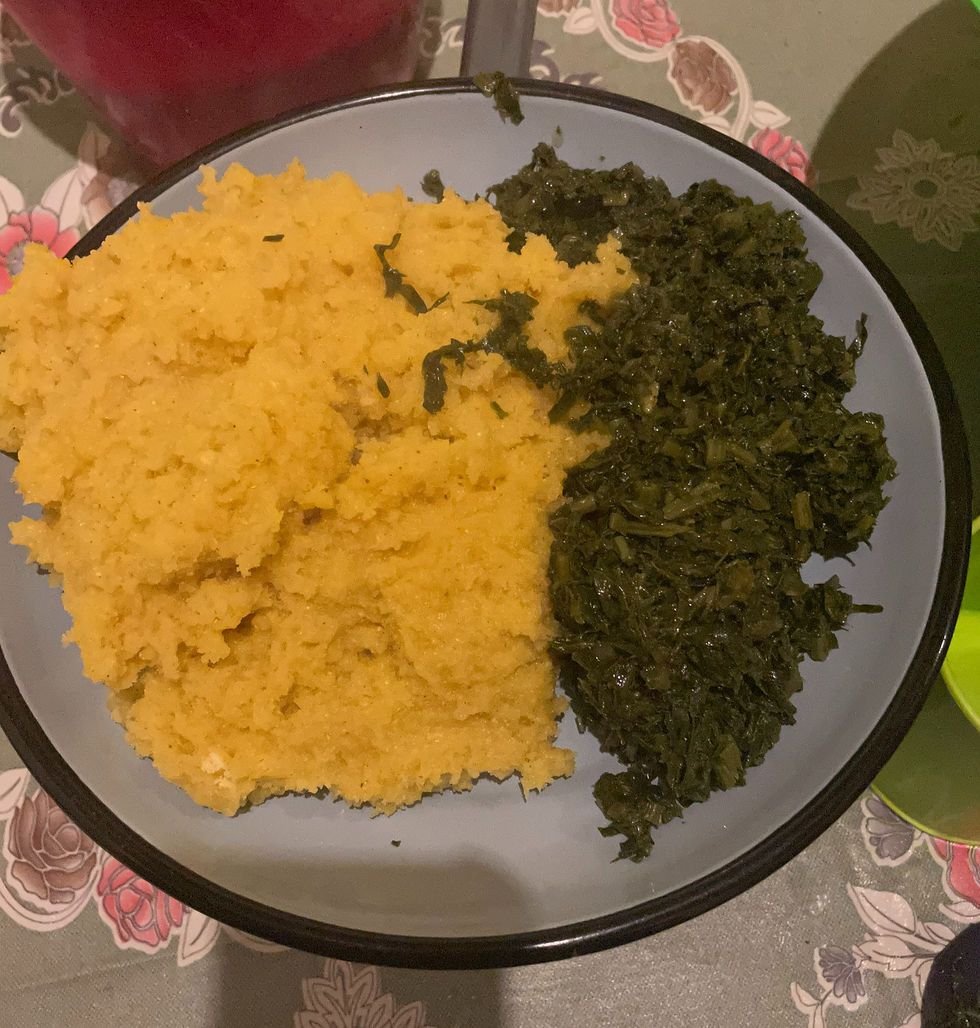Kea Pheha
- Kenna Heroy
- Jan 28, 2023
- 3 min read
Updated: Apr 8, 2023
Kea pheha (KAY-ah PAY-ha)…I cook! I’ve talked about food in previous posts, but I wanted to make one that has a couple different traditional recipes so y’all can see what really goes into it. For now, I’m going to talk about papa and moroho, the two most popular dishes here.
Papa

Papa is usually cooked outside in a big pot, which is the way I’m going to show here. It can also be cooked on the stove, however, which people do if it’s raining. Making papa is actually pretty simple. The most challenging thing is getting the proportion of maize meal to water

right. First, put the pot of water over the fire and wait for it to boil. Then, pour in the maize meal. I honestly don’t know the proportion because I’ve only ever seen them eyeball it. I tried to make it on my stove the other night, and the proportions on the bag weren't accurate.

So I’ll just be eyeballing it too from now on…maybe eventually I’ll be as good as a Mosotho cook. After pouring in the maize meal, stir, stir, stir. And stir some more. Lots of stirring. Then cover with the lid and wait. There’s no specific waiting time - I asked Alice and she said it depends on the amount you're

cooking. But it’s about 15 minutes, then take off the lid and stir some more. Then wait another 15 ish (emphasis on the ish) minutes and it’s ready!
More details from when I made papa myself: I did eventually get the proportions right. However, at first I thought I had burned it because there was black along the outside. Turns out it was just the coating of the pot coming off, so I had some unexpected seasoning:) Just kidding, I didn’t eat the coating. The papa without coating in it turned out pretty good!
Moroho

Making moroho is more challenging, in my opinion, than papa. At least, there’s more work that goes into it because of the chopping. Moroho just means vegetables, so the dish itself can be made with spinach, cabbage, rapeseed, etc. First, chop the leaves. The way they chop here is pretty different from what

I’ve ever seen before, and it took a bit to get the hang of. I still end up with pieces that are too big. Practice definitely makes perfect in this case. After chopping, which takes a while because it’s usually the whole head of cabbage or a similar amount of another leafy vegetable, add to a pot with some oil. Cover and wait a

bit, again there’s no exact time; maybe 10 minutes. Then season. We’ve used salt, chicken spice (which is kind of like seasoned salt), cayenne pepper, and some others. Stir, and cover for another maybe 10 minutes and it’s ready! Best served with papa in my opinion, which it often is. It’s easy to eat with your hands using papa as a “spoon” too, though there’s more technique to this than I initially thought. Again, practice makes perfect. Below is the finished meal!

Hlatsoa Lijana (shl-AHT-swa dee-JAH-nah)

I can’t cook without washing dishes, or hlatsoa lijana! Pictured on the left is the basin I wash them in. The green bucket below the table is my water bucket. I want to get a bigger basin eventually so it’ll be easier, but this works for now. I pour in water and soap, then use the rag on top of the dishes in the picture below to wash everything. I set the washed dishes aside on the table, since I can only fit a couple things in the basin at once. After they’re all clean, I dump the water and rinse

everything. I have a dish drying rack, which is super nice and lives by my stove, pictured on the right. I put the rinsed dishes on there, then carry it to its place. That’s all there is to it! It doesn’t take super long usually, though I have learned that leaving things dirty for a couple days makes it challenging to get some of the food residue off. I try to wash dishes every day now, though that doesn’t always happen…but I do my best.
Thanks for joining me on my cooking adventures! These two dishes are just a couple that I’ve made since being here. It's been interesting to learn how they cook food here, and experiencing the different variety. Cooking on my little two burner stove has also been a learning curve, and I'm definitely getting the hang of it and trying out new recipes. Bye for now, and happy cooking!









We love reading your posts. We especially enjoy learning of the various aspects of the culture. I spent several weeks with the Navajos working with them. I was to be the teacher; I learned so much more than the students. Looking forward to your next post.